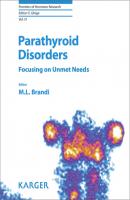Parathyroid Disorders. Группа авторов
Чтение книги онлайн.

Читать онлайн книгу Parathyroid Disorders - Группа авторов страница 6
Название: Parathyroid Disorders
Автор: Группа авторов
Издательство: Ingram
Жанр: Биология
Серия: Frontiers of Hormone Research
isbn: 9783318064094
isbn:
Surgical Management
Patients with symptomatic PHPT as well as asymptomatic patients who meet any one of the guideline criteria should be advised to undergo parathyroidectomy [4, 24]. Table 3 shows the indication of surgery in PHPT. Surgical consultation can be offered to those who do not meet guidelines for surgery.
Genetic testing is advised for patients suspected of having a genetic disorder, such as young patients (<30 years of age), patients with syndromic findings and/or a positive family history of syndromic PHPT, and patients with multiglandular disease, such as parathyroid carcinoma [4]. The surgical approach for patients with a genetic etiology may differ from those with a sporadic parathyroid adenoma, in that multiglandular disease is more common when there is a genetic etiology. Preoperative localization studies are recommended with ultrasound, 99mTc-sestamibi nuclear scintigraphy, CT, MRI, or PET scans. The choice of preoperative imaging depends on the experience of the surgical center.
Medical Therapies
Adequate hydration and avoidance of dehydration is always recommended. Calcium intake should not be restricted and should follow national guidelines. 25-hydroxyvitamin D levels >20 ng/mL are recommended, although some experts continue to recommend levels of >30 ng/mL. Concerning supplied vitamin D when needed, initial doses of 600–1,000 IU daily are recommended, and serum calcium levels should be monitored during vitamin D supplementation [4].
Cinacalcet, a calcimimetic, is approved for specific indications in PHPT by the European Medicines Agency (EMA) and the US Food and Drug Administration (FDA). The EMA approved the use of cinacalcet for patients with hypercalcemia who meet surgical criteria but in whom parathyroidectomy is not possible or not clinically “appropriate.” The FDA approval is for severe hypercalcemia in patients with PHPT who are unable to undergo parathyroidectomy. Adverse effects of cinacalcet include nausea, vomiting, diarrhea, and headache, but are uncommon when the single 30-mg daily dose is used [4].
Alendronate, a bisphosphonate, improved BMD in patients with PHP. In patients who require both a reduction in serum calcium levels and an improvement in BMD, combination therapy with cinacalcet and alendronate is reasonable, but has only been studied in a retrospective manner [4].
References
1Silva BC, Bilezikian JP: Parathyroid hormone: anabolic and catabolic actions on the skeleton. Curr Opin Pharmacol 2015;22:41–50.
2Bandeira F, Griz L, Chaves N, Carvalho NC, Borges LM, Lazaretti-Castro M, Borba V, Castro LC, Borges JL, Bilezikian J: Diagnosis and management of primary hyperparathyroidism – a scientific statement from the Department of Bone Metabolism, the Brazilian Society for Endocrinology and Metabolism. Arq Bras Endocrinol Metabol 2013;57:406–424.
3Yu N, Donnan PT, Murphy MJ, Leese GP: Epidemiology of primary hyperparathyroidism in Tayside, Scotland, UK. Clin Endocrinol 2009;71:48.
4Bilezikian JP, Cusano NE, Khan AA, Liu J-M, Marcocci C, Bandeira F: Primary hyperparathyroidism. Nat Rev Dis Primers 2016;19:16033.
5Bandeira F, Correia A: Clinical presentation of primary hyperparathyroidism: a global perspective; in Bilezikian J, Marcus R, Levine MA, Marcocci C, Silverberg SJ, Potts JT Jr (eds): The Parathyroids, ed 3. Cambridge, Academic Press, 2015, pp 309–314.
6Bilezikian JP, Bandeira L, Khan A, Cusano NE: Hyperparathyroidism. Lancet 2018;391:168–178.
7Horwitz MJ, Hodak SP, Stewart AF: Non-parathyroid hypercalcemia; in CJ Rosen (ed): Primer on the metabolic bone diseases and disorders of mineral metabolism, ed 8. Hoboken, Wiley-Blackwell, 2013, pp 562–571.
8Ziegler R: Clinical picture of humoral hypercalcemia of malignancy. Recent Results Cancer Res 1994;137:107–113.
9Stewart AF: Hypercalcemia associated with cancer. N Engl J Med 2005;352:373–379.
10Evans KN, Taylor H, Zehnder D, Kilby MD, Bulmer JN, Shah F, Adams JS, Hewison M: Increased expression of 25-hydroxyvitamin D-1α-hydroxylase in dysgerminomas: a novel form of humoral hypercalcemia of malignancy. Am J Pathol 2004;165:807–813.
11Brickman AS: Disorders of calciotropic hormones in adults; in Lavin N (ed): Manual Endocrinology and Metabolism. Philadelphia, Lippincott Eilliams & Wilkins, 2014, pp 293–323.
12Gaudio A, Pennisi P, Bratengeier C, Torrisi V, Lindner B, Mangiafico RA, Pulvirenti I, Hawa G, Tringali G, Fiore CE: Increased sclerostin serum levels associated with bone formation and resorption markers in patients with immobilization-induced bone loss. J Clin Endocrinol Metab 2010;95:2248–2253.
13Herfarth K, Schmidt-Gayk H, Graf S, Maier A: Circadian rhythm and pulsatility of parathyroid hormone secretion in man. Clin Endocrinol 1992;37:511–519.
14Schmitt CP, Schaefer F, Bruch A, Veldhuis JD, Schmidt-Gayk H, Stein G, Ritz E, Mehls O: Control of pulsatile and tonic parathyroid hormone secretion by ionized calcium. J Clin Endocrinol Metab 1996;81:4236–4243.
15Abood A, Vestergaard P: Increasing incidence of primary hyperparathyroidism in Denmark. Dan Med J 2013;60:A4567.
16Dalemo S, Hjerpe P, Bostrom Bengtsson K: Diagnosis of patients with raised serum calcium level in primary care, Sweden. Scand J Prim Health Care 2006;24:160–165.
17Griebeler ML, Kearns AE, Ryu E, Thapa P, Hathcock MA, Melton LJ 3rd, Wermers RA: Thiazide-associated hypercalcemia: СКАЧАТЬ